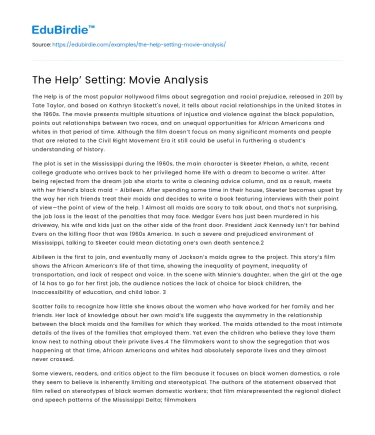The Help is of the most popular Hollywood films about segregation and racial prejudice, released in 2011 by Tate Taylor, and based on Kathryn Stockett's novel, it tells about racial relationships in the United States in the 1960s. The movie presents multiple situations of injustice and violence against the black population, points out relationships between two races, and on unequal opportunities for African Americans and whites in that period of time. Although the film doesn’t focus on many significant moments and people that are related to the Civil Right Movement Era it still could be useful in furthering a student’s understanding of history.
The plot is set in the Mississippi during the 1960s, the main character is Skeeter Phelan, a white, recent college graduate who arrives back to her privileged home life with a dream to become a writer. After being rejected from the dream job she starts to write a cleaning advice column, and as a result, meets with her friend’s black maid – Aibileen. After spending some time in their house, Skeeter becomes upset by the way her rich friends treat their maids and decides to write a book featuring interviews with their point of view—the point of view of the help. 1 Almost all maids are scary to talk about, and that’s not surprising, the job loss is the least of the penalties that may face. Medgar Evers has just been murdered in his driveway, his wife and kids just on the other side of the front door. President Jack Kennedy isn’t far behind Evers on the killing floor that was 1960s America. In such a severe and prejudiced environment of Mississippi, talking to Skeeter could mean dictating one’s own death sentence.2
Save your time!
We can take care of your essay
- Proper editing and formatting
- Free revision, title page, and bibliography
- Flexible prices and money-back guarantee
Aibileen is the first to join, and eventually many of Jackson’s maids agree to the project. This story’s film shows the African American’s life of that time, showing the inequality of payment, inequality of transportation, and lack of respect and voice. In the scene with Minnie’s daughter, when the girl at the age of 14 has to go for her first job, the audience notices the lack of choice for black children, the inaccessibility of education, and child labor. 3
Scatter fails to recognize how little she knows about the women who have worked for her family and her friends. Her lack of knowledge about her own maid’s life suggests the asymmetry in the relationship between the black maids and the families for which they worked. The maids attended to the most intimate details of the lives of the families that employed them. Yet even the children who believe they love them know next to nothing about their private lives.4 The filmmakers want to show the segregation that was happening at that time, African Americans and whites had absolutely separate lives and they almost never crossed.
Some viewers, readers, and critics object to the film because it focuses on black women domestics, a role they seem to believe is inherently limiting and stereotypical. The authors of the statement observed that film relied on stereotypes of black women domestic workers; that film misrepresented the regional dialect and speech patterns of the Mississippi Delta; filmmakers failed to acknowledge black women’s vulnerability to sexual harassment and assault; paid insufficient attention to the civil rights activism of the period.5
That’s a fact that the movie does not focus the audience's attention on many significant figures and events of that time. The critics state that The Help takes the racial terror out of the 1960s by ignoring the bombings, shootings, and beatings and replacing the Ku Klux Klan with snotty Junior Leaguers who were mean to their maids. 6 The truth is that terror and violence were not limited to political marches or assassinations, there were plenty of both.
The audience needs to be critical, while The Help tells several women’s stories, we must understand that these are not the only stories and that Mississippi and the 1960s are not the only place or times of such a flagrant lack of civil rights.7 The Help’s main purpose is not to show all the historical events of that time, but rather to entertain the people. But despite that, the film is full of accurate historical moments, that help students better understand the Era of Segregation and the Civil Right Movement of the 1960s.






 Stuck on your essay?
Stuck on your essay?

